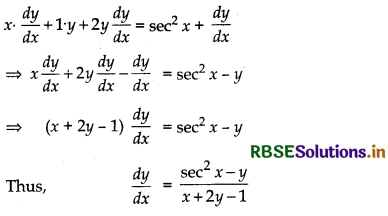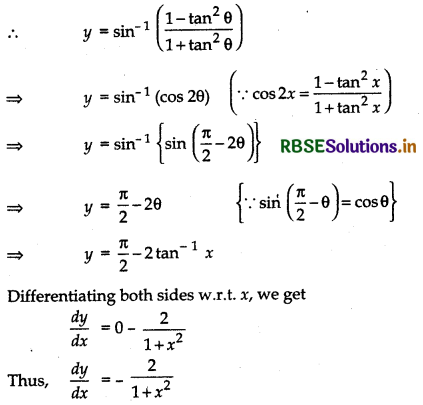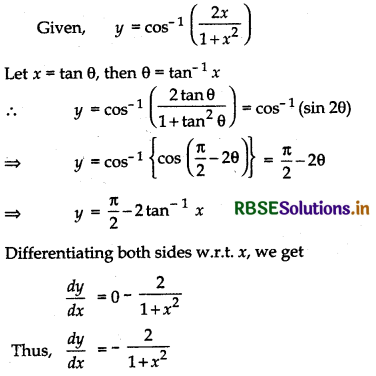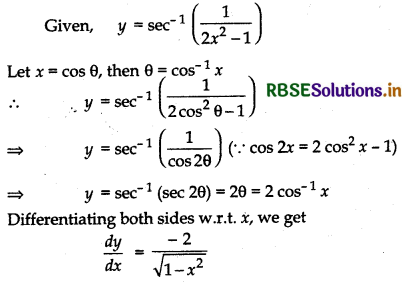RBSE Solutions for Class 12 Maths Chapter 5 Continuity and Differentiability Ex 5.3
Rajasthan Board RBSE Solutions for Class 12 Maths Chapter 5 Continuity and Differentiability Ex 5.3 Textbook Exercise Questions and Answers.
Rajasthan Board RBSE Solutions for Class 12 Maths in Hindi Medium & English Medium are part of RBSE Solutions for Class 12. Students can also read RBSE Class 12 Maths Important Questions for exam preparation. Students can also go through RBSE Class 12 Maths Notes to understand and remember the concepts easily.
RBSE Class 12 Maths Solutions Chapter 5 Continuity and Differentiability Ex 5.3
Find \(\frac{d y}{d x}\) in the following:
Question 1.
2x + 3y = sin x
Answer:
Given, 2x + 3y = sin x
Differentiating both sides w.r.t. x, we get
2.1 + 3\(\frac{d y}{d x}\) = cos x ⇒ 3\(\frac{d y}{d x}\) = cos x - 2
Thus, \(\frac{d y}{d x}\) = \(\frac{\cos x-2}{3}\)

Question 2.
2x + 3y = sin y
Answer:
Given, 2x + 3y = sin y
Differentiating both sides w.r.t. x, we get
2.1 + 3\(\frac{d y}{d x}\) = cos y \(\frac{d y}{d x}\)
⇒ 2 = cos y \(\frac{d y}{d x}\) - 3\(\frac{d y}{d x}\) ⇒ 2 = (cos y - 3) \(\frac{d y}{d x}\)
Thus, \(\frac{d y}{d x}\) = \(\frac{2}{\cos y-3}\)
Question 3.
ax + by2 = cos y
Answer:
Given, ax + by2 = cos y
Differentiating both sides w.r.t. x, we get
a.1 = 2by\(\frac{d y}{d x}\) = - sin y \(\frac{d y}{d x}\)
⇒ (sin y + 2by) \(\frac{d y}{d x}\) = - a
Thus, \(\frac{d y}{d x}\) = \(\frac{-a}{\sin y+2 b y}\)

Question 4.
xy + y2 = tan x + y
Answer:
Given xy + y2 = tan x + y
Differentiating both sides w.r.t. x, we get
x. \(\frac{d y}{d x}\) + 1.y + 2y \(\frac{d y}{d x}\) = sec2 x + \(\frac{d y}{d x}\)

Question 5.
x2 + xy + y2 = 100
Answer:
Given, x2 + xy + y2 = 100
Differentiating both sides w.r.t. x, we get
2x + x. \(\frac{d y}{d x}\) + 1.y + 2y \(\frac{d y}{d x}\) = 0
⇒ (x + 2y) \(\frac{d y}{d x}\) = - y - 2x = - (y + 2x)
Thus, \(\frac{d y}{d x}\) = -\(\frac{(y+2 x)}{(x+2 y)}\)
Question 6.
x3 + x2y + xy2 + y3 = 81
Answer:
Given x3 + x2y + xy2 + y3 = 81
Differentiating both sides w.r.t. x, we get
3x2 + 2xy + x2\(\frac{d y}{d x}\) + 1.y2 + x.2y\(\frac{d y}{d x}\) + 3y2\(\frac{d y}{d x}\) = 0
⇒ 3x2 + 2xy + y2 + (x2 + 2xy + 3y2) \(\frac{d y}{d x}\) = 0
⇒ (x2 + 2xy + 3y2)\(\frac{d y}{d x}\) = - (3x2 + 2xy + y2)
Thus, \(\frac{d y}{d x}\) = - \(\frac{\left(3 x^{2}+2 x y+y^{2}\right)}{\left(x^{2}+2 x y+3 y^{2}\right)}\)

Question 7.
sin2 y + cos xy = k
Answer:
Given, sin2 y + cos xy = k
Differentiating both sides w.r.t. x, we get
2 sin y cos y \(\frac{d y}{d x}\) + (- sin xy) (x \(\frac{d y}{d x}\) + 1.y) = 0
⇒ sin 2y \(\frac{d y}{d x}\) - x sin xy \(\frac{d y}{d x}\) - y sin xy = 0
[∵ 2 sin y cos y = sin2y]
⇒ (sin 2y - x sin xy)\(\frac{d y}{d x}\) = y sin xy
Thus, \(\frac{d y}{d x}\) = \(\frac{y \sin x y}{(\sin 2 y-x \sin x y)}\)
Question 8.
sin2 x + cos2 y = 1
Answer:
Given sin2 x + cos2 y = 1
Differentiating both sides w.r.t. x, we get
2 sin x cos x - 2 cos y sin y \(\frac{d y}{d x}\) = 0
⇒ sin 2x - sin 2y \(\frac{d y}{d x}\) = 0
⇒ - sin 2y \(\frac{d y}{d x}\)= - sin 2x
⇒ \(\frac{d y}{d x}\) = \(\frac{-\sin 2 x}{-\sin 2 y}=\frac{\sin 2 x}{\sin 2 y}\)
Thus, \(\frac{d y}{d x}\) = \(\frac{-\sin 2 x}{-\sin 2 y}=\frac{\sin 2 x}{\sin 2 y}\)
Question 9.
y = sin-1\(\left(\frac{2 x}{1+x^{2}}\right)\)
Answer:
Given y = sin-1\(\left(\frac{2 x}{1+x^{2}}\right)\)
Differentiating both sides w.r.t. x, we get

Alternatively:
y = sin-1 \(\left(\frac{2 x}{1+x^{2}}\right)\)
let x = tan θ,
Then θ = tan-1 x
∴ y = sin-1 \(\left(\frac{2 \tan \theta}{1+\tan ^{2} \theta}\right)\)
⇒ y = sin-1 (sin 2θ)
⇒ y = 2θ (∵ sin 2θ = \(\frac{2 \tan \theta}{1+\tan ^{2} \theta}\))
⇒ y = 2 tan-1 x
Differentiating both sides w.r.t. x, we get
\(\frac{d y}{d x}\) = \(\frac{2}{1+x^{2}}\)

Question 10.
y = tan-1\(\left(\frac{3 x-x^{3}}{1-3 x^{2}}\right)\), - \(\frac{1}{\sqrt{3}} < x < \frac{1}{\sqrt{3}}\)
Answer:
Given y = tan-1\(\left(\frac{3 x-x^{3}}{1-3 x^{2}}\right)\)
Let x = tan θ then θ = tan-1 x
and y = tan-1\(\left(\frac{3 \tan \theta-\tan ^{3} \theta}{1-3 \tan ^{2} \theta}\right)\)
⇒ y = tan-1 (tan 3θ) = 3θ
⇒ y = 3 tan-1 x
Differentiating both sides w.r.t x, we get
\(\frac{d y}{d x}\)= \(\frac{3}{1+x^{2}}\)
Question 11.
y = cos-1 \(\left(\frac{1-x^{2}}{1+x^{2}}\right)\), 0 < x < 1
Answer:
Given, y = cos-1\(\left(\frac{1-x^{2}}{1+x^{2}}\right)\), 0 < x < 1
Let x = tan θ then θ = tan-1x
and y = cos-1\(\left(\frac{1-\tan ^{2} \theta}{1+\tan ^{2} \theta}\right)\)
⇒ y = cos-1 (cos 2θ) = 2θ = 2 tan-1x
Differentiating both sides w.r.t x, we get
\(\frac{d y}{d x}\) = \(\frac{2}{1+x^{2}}\)
Question 12.
y = sin-1\(\left(\frac{1-x^{2}}{1+x^{2}}\right)\), 0 < x < 1
Answer:
Given y = sin-1\(\left(\frac{1-x^{2}}{1+x^{2}}\right)\)
Let x = tan θ, then θ = tan-1 x


Question 13.
y = cos-1\(\left(\frac{2 x}{1+x^{2}}\right),\) - 1 < x < 1
Answer:

Question 14.
y = sin-1 (2x\(\sqrt{1-x^{2}}\)), -\(\frac{1}{\sqrt{2}}\) < x < \(\frac{1}{\sqrt{2}}\)
Answer:
Given y = sin-1 (2x\(\sqrt{1-x^{2}}\))
Let x = sin θ, then θ = sin-1 x
and y = sin-1 (2 sin θ \(\sqrt{1-\sin ^{2} \theta}\))
⇒ y = sin-1 (2 sin θ cos θ)
⇒ y = sin-1 (sin 2θ) = 2θ = 2 sin-1 x
Differentiating both sides w.r.t x, we get
\(\frac{d y}{d x}\) = 2 \(\frac{d}{d x}\) (sin-1 x)
Thus, \(\frac{d}{d x}\) = \(\frac{2}{\sqrt{1-x^{2}}}\)

Question 15.
y = sec-1\(\left(\frac{1}{2 x^{2}-1}\right)\), 0 < x < \(\frac{1}{\sqrt{2}}\)
Answer:


- RBSE Class 12 Maths Notes Chapter 13 Probability
- RBSE Class 12 Maths Notes Chapter 12 Linear Programming
- RBSE Class 12 Maths Notes Chapter 11 Three Dimensional Geometry
- RBSE Class 12 Maths Notes Chapter 10 Vector Algebra
- RBSE Class 12 Maths Notes Chapter 9 Differential Equations
- RBSE Class 12 Maths Notes Chapter 8 Application of Integrals
- RBSE Class 12 Maths Notes Chapter 7 Integrals
- RBSE Class 12 Maths Notes Chapter 6 Application of Derivatives
- RBSE Class 12 Maths Notes Chapter 5 Continuity and Differentiability
- RBSE Class 12 Maths Notes Chapter 4 Determinants
- RBSE Class 12 Maths Notes Chapter 3 Matrices